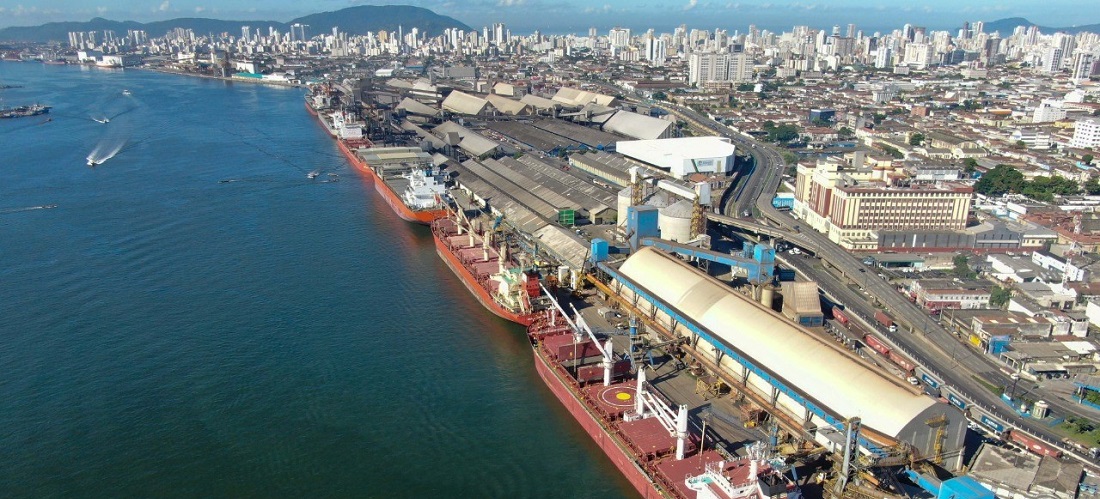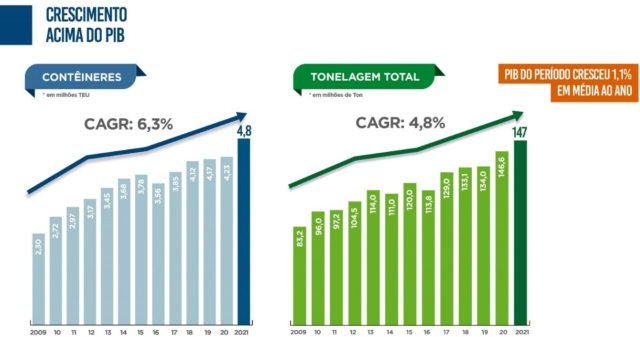
The Port of Santos sets new annual record in 2021 driven by the increased flow of containers, soybeans and fertilizers
Jan, 26, 2022 Posted by Gabriel MalheirosWeek 202204
The Port of Santos finished 2021 with a new cargo handling record of 47.0 million tons, 0.3 percent more than in 2020. Increases in container, soybean, and fertilizer handling were critical to achieving this result.
Import cargoes stood out with an increase of 10.4%, totaling 43.9 million tons. Export cargoes, on the other hand, fell by 3.5%, reaching 103.1 million tons.
Containerized cargoes showed an expressive growth of 14.2%, expanding the handling to 4.8 million TEU, after strong and consecutive monthly increases throughout the year. The Port of Santos set a new monthly record for this type of cargo in December, with 452.6 thousand TEU, a 3.5 percent increase over December 2020.
The Port of Santos has grown at a compound annual rate higher than the average GDP over the last 12 years. From 2009 to 2021, the annual increase in tonnage at the Port of Santos was 4.9%, while container handling rates increased by 6.6%. In the same time frame, Brazilian GDP increased by an average of 1.1% per year – taking into account the most recent GDP forecast for 2021, which is 4.51%.
Soybean transportation in bulk has also stood out, with a 10.5 percent increase in handling rate over the previous year, reaching 23.3 million tons, demonstrating the strength of agribusiness. Fertilizers, on the other hand, led the list of imported loads, increasing 21.5 % and totaling 8 million tons.
Marcelo Ribeiro, Director of Operations, warns of the need to invest in new infrastructure for container operations in order to sustain this growth. “We currently have a capacity of 5.3 million TEU.” “The SPA, the National Waterway Transport Agency (Antaq), and the Ministry of Infrastructure (Minfra) are already planning an auction for a new container operation area, STS 10, which should take place in the second half of this year,” Ribeiro explains.
Ribeiro adds the importance of expanding the handling capacity for fertilizers as well. “STS 53 is crucial for Santos to provide adequate infrastructure for this type of cargo. Due to a lack of installed capacity, we are currently unable to meet the volume of fertilizer in our area of influence,” he says.
Shipments of fuel oil, which totaled 2.9 million tons (+32.4%), and citrus juices, with 2.3 million tons (+11.9%), as well as wheat landings, 1 .3 million tons (+21.4%), were among the highlights noted among 2021 handling. Sugar and corn presented a reduction of, respectively, 14.6%, reaching 20.6 million tons, and 37.9%, reaching 9.0 million tons.
Last year, a total of 4,856 ships docked at the Port of Santos. This number was 1% lower than in 2020. The reduction in the number of ships along with the increase in cargo handling indicates the arrival of larger ships to Santos, which allows for better operational performance and increased productivity.
Commercial chain
Santos had a 27 percent share of the Brazilian commercial chain. China was a partner country in approximately 25.3% of all foreign trade transactions that passed through the Port of Santos. Thus, São Paulo, through Santos, continues to be the state with the highest participation in foreign trade transactions, at 56.5%
-
Other Cargo
Apr, 09, 2025
0
USA Becomes the Largest Importer of Brazilian Eggs
-
Ports and Terminals
Apr, 09, 2024
0
Chancay Megaport: Construction Progressing as Planned
-
Blog News (ENG)
Jul, 18, 2022
0
Orange juice: exported volume falls in the 2021/22 season
-
Meat
Sep, 30, 2021
0
US earmarks $500 million to prevent African swine fever


